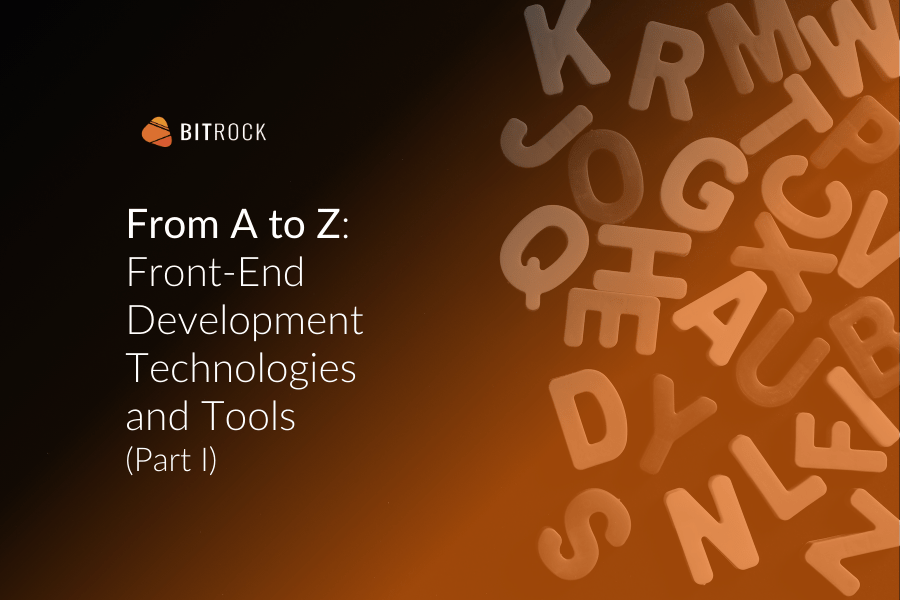The world of web development requires the use of a wide range of front-end technologies and tools to create responsive and functional user interfaces. From HTML, CSS, and JS to advanced frameworks, and tools to optimize development workflows, the range of technologies is vast and constantly evolving.
That’s why we thought it would be a good idea to create the ultimate A to Z list for Front-End Development. We went through letter-by-letter and picked what we felt to be the technologies and the tools that most nobly represented all the letters of the alphabet, then laid out exactly why. From Angular, to Zeplin, passing through Flutter and React – they’re all here!
A is for Angular
Angular is a JavaScript framework developed by Google and used to build single-page applications (SPAs) and dynamic web applications. Its main feature is to organize code into reusable modules and components. Based on TypeScript, Angular provides static typing that helps you identify code errors during development, thereby making your applications more robust.
Angular introduces the concept of “two-way data binding“, which allows synchronization of data between view and model. This simplifies application state management and improves greater interactivity. Additionally, the framework provides a range of built-in features such as routing, state management, form validation, testability, and integration with external services.
B is for Babel
Babel is a JavaScript compiler tool that allows developers to write code using the latest language features and convert it into a format compatible with older browser versions. This tool is very important for cross-browser compatibility as it allows older browsers to use the latest JavaScript features. Babel is highly configurable and customizable, allowing developers to tailor it to the specific needs of their projects, increasing development productivity and ensuring a consistent experience for end users.
C is for Cypress
Cypress is a powerful end-to-end (E2E) testing framework designed specifically for front-end development, known for its user-friendly nature, and reliability. Cypress allows users to simulate user interactions, run tests across different browsers simultaneously, access the DOM directly , and write tests declaratively through a simple and intuitive API. Serverless architecture enables fast and reliable tests, providing instant feedback during development.
Due to Its open-source nature and active community, Cypress is a popular choice among developers to ensure the quality and reliability when it comes to ensuring the quality and reliability of front-end applications throughout the development process.
D is for D3.js
D3.js short for “Data-Driven Documents,” is one of the most powerful and flexible libraries for data manipulation and creating dynamic visualizations on the web. With its versatility and power, D3.js enables developers to transform complex data into clear and engaging visualizations, creating charts, geographical maps, bar charts, histograms, pie charts, and a wide range of other visual representations.
What makes D3.js unique is its approach which is based on the fundamental concepts of manipulating the Document Object Model (DOM) with data. This means that D3.js allows direct data binding to DOM elements, providing greater flexibility and control in creating custom and interactive visualizations.
The library provides a powerful set of tools for dynamically handling data presentation, enabling smooth transitions between different view states. D3.js leverages SVG (Scalable Vector Graphics) and Canvas features to create highly customizable and high-performance charts that scale to different sizes and devices.
E is for ESLint
ESLint is a JavaScript Linting tool widely used by the software development community. It works by analyzing JavaScript code to identify errors, style inconsistencies, and potential problems. For example, it identifies common errors such as undeclared variables, dead code, or style inconsistencies, helping developers to write cleaner, more readable, and maintainable code. The result of working with ESLint is an improvement in the overall quality of the code.
ESLint is often integrated into development processes, such as pre-commit checks or within Continuous Integration/Continuous Deployment (CI/CD) workflows, to ensure that the code conforms to defined standards and to identify potential problems during development, reducing the likelihood of errors in production.
F is for Flutter
Flutter is an open-source framework developed by Google for creating native applications for mobile, web, and desktop. Based on the Dart language, with its highly customizable widgets and support for hot reload, Flutter simplifies the development process and allows developers to create cross-platform applications with a single code base.
G is for GraphQL
GraphQL is a query language for APIs, designed to provide an efficient and flexible way to request and deliver data from a server to a client. Unlike traditional REST APIs, GraphQL allows clients to specify exactly the data they need, reducing the amount of data transferred and improving application performance. This allows developers to precisely define the structure of requests to get exactly the desired data, providing greater flexibility and scalability in optimizing API requests.
H is for Husky
Husky is a tool primarily used to manage pre-commit hooks in Git repositories. Pre-commit hooks are scripts that are automatically executed before a commit is created in the repository. These scripts enable various checks or actions to be performed on the code before it is committed, ensuring code quality and consistency. This allows developers to easily define and run custom scripts or specific commands to perform tests, Code Linting, formatting checks, and other necessary validations before making a commit to a shared repository.
I is for Immer
Immer is a JavaScript library that simplifies the management of immutable state. By using Immer, developers can easily produce and manipulate immutable data structures more intuitively. The library provides a simpler and more readable approach to updating immutable objects, allowing developers to write clearer and more maintainable code when managing application state.
Immer is particularly useful in contexts such as React applications, Redux, or any situation where maintaining stability and predictability of the state is critical. Its developer-friendly features and functional programming approach have made it an attractive alternative to the more popular Immutable.js.
J is for Jest
Jest is a JavaScript testing framework known for its ease of use, simple configuration, and execution speed. Jest is widely used for conducting unit tests and integration testing.
One of the main advantages of Jest is its comprehensive and integrated structure, which includes everything needed to perform tests efficiently. It comes with features such as built-in automocking that simplifies dependency substitution, support for asynchronous testing, and parallel test execution that improves productivity and reduces execution times.
K is for Kotlin
Kotlin is a modern and versatile programming language that can be used to develop applications for multiple platforms, including Android, web, server-side, and more.
Recognized for its conciseness, clarity, and interoperability with Java, Kotlin offers many advanced features that increase developer productivity. Thanks to its expressive syntax and type safety, Kotlin has become a popular choice for developers who want to write clean and maintainable code across platforms. Although it’s not strictly a web technology, its importance and steady growth in mobile application development deserve to be mentioned.
L is for Lodash
Lodash is a JavaScript library that provides a set of utility functions for data manipulation, array handling, object management, and more. It is known for providing efficient and performant methods that make it easier to write more concise and readable code. Lodash includes a wide range of utility functions such as map, filter, and many others that allow developers to work with complex data easily and efficiently.
In addition to utility functions, Lodash also provides support for string manipulation, number handling, creating iterator functions, and other advanced operations that make data management more intuitive and powerful.
M is for Material-UI
Material-UI is a React-based UI component library based on Google’s Material Design system. It offers a wide range of pre-styled and configurable components to help developers efficiently create modern and intuitive interfaces. The library provides a comprehensive collection of components such as buttons, inputs, navigation bars, tables, cards, and more. Each component is designed to follow Material Design guidelines, providing a consistent and professional look and feel throughout the application. In addition to providing predefined components, Material UI also allows for customization through themes and styles. Developers can easily customize the look and feel of components to meet specific project requirements while maintaining an overall consistent design.
N is for Node.js
How could Node.js not be mentioned on this list? Well, here we are, Node is an open-source JavaScript runtime based on Google Chrome’s V8 engine, that enables server-side execution of JavaScript code. It is widely used for building scalable and fast web applications, allowing developers to use JavaScript on both the client and server sides. Node.js offers high efficiency through its non-blocking asynchronous model, which enables efficient handling of large numbers of requests. With its extensive module ecosystem (npm), Node.js is a popular choice for developing web applications, APIs, and back-end services.
We’re only halfway through our exploration of the ultimate A to Z list for Front-End Development!
Stay tuned for the second act, as we’re going to explore some more interesting tools and technologies, each pushing the boundaries of front-end development.
Main Author: Mattia Ripamonti, Team Leader and Front-End Developer @ Bitrock


